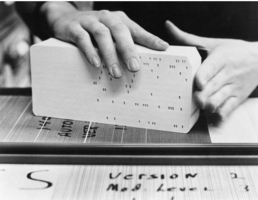Utilização de modelos virtuais tridimensionais na interação com a informação georreferenciada
Esta pesquisa tem como finalidade explorar os recursos de interação do usuário com a informação georreferenciada, utilizando o próprio ambiente físico e seus elementos como interface. A indexação geográfica de arquivos digitais e os recursos disponíveis pela computação móvel estabeleceram um novo modelo de interação com a informação. Cabe ao designer criar sistemas e interfaces que levem em consideração a localização do usuário no acesso da informação atribuída ao entorno. Foi identificado que as soluções desenvolvidas para esse propósito utilizam telas e outros aparatos tecnológicos que constrangem a relação do usuário com o ambiente e interferem na experiência interativa. Como desdobramento da pesquisa foi desenvolvido um aplicativo que dispensa a tela na visualização e interação com a camada informacional do ambiente físico. O sistema utiliza os sensores de localização e orientação presentes nos smartphones para interagir com o entorno mapeado e georreferenciado. Dessa forma, o usuário, ao apontar o aparelho e selecionar diretamente o objeto de interesse, recebe os dados atribuídos a ele. Sem a interferência de telas ou dispositivos imersivos, o próprio ambiente se apresenta como interface de interação, dispensando novos ícones ou símbolos e tornando a tecnologia mais sutil em seu uso cotidiano.
This research aims to explore the features of user interaction with georeferenced information by using the physical environment and its elements as interface. The use of geotags in digital files and the popularization of mobile computing established a new model of information-based interaction. It is up to the designer to create systems and interfaces that take into account the user location when accessing the surrounding information. It was identified that the screen-based solutions and other technological devices that constrain the relation between the user and the environment, interfere with the interactive experience. As an outcome of the research, a mobile application was developed that spares the use of displays at the act of selecting points of interest in the physical environment interaction. The system is based on smartphones' location and orientation sensors data to establish the interaction with the georeferenced and modeled surrounding elements. Thus, the user points the device and directly select the object of interest, in order to receive the data assigned to it. Without the interference of screens or immersive devices, the environment itself is presented as an interaction interface, avoiding the overlapping of new icons or symbols and making technology more subtle in its daily use.
Esta pesquisa tem como finalidade explorar os recursos de interação do usuário com a informação georreferenciada, utilizando o próprio ambiente físico e seus elementos como interface. A indexação geográfica de arquivos digitais e os recursos disponíveis pela computação móvel estabeleceram um novo modelo de interação com a informação. Cabe ao designer criar sistemas e interfaces que levem em consideração a localização do usuário no acesso da informação atribuída ao entorno. Foi identificado que as soluções desenvolvidas para esse propósito utilizam telas e outros aparatos tecnológicos que constrangem a relação do usuário com o ambiente e interferem na experiência interativa. Como desdobramento da pesquisa foi desenvolvido um aplicativo que dispensa a tela na visualização e interação com a camada informacional do ambiente físico. O sistema utiliza os sensores de localização e orientação presentes nos smartphones para interagir com o entorno mapeado e georreferenciado. Dessa forma, o usuário, ao apontar o aparelho e selecionar diretamente o objeto de interesse, recebe os dados atribuídos a ele. Sem a interferência de telas ou dispositivos imersivos, o próprio ambiente se apresenta como interface de interação, dispensando novos ícones ou símbolos e tornando a tecnologia mais sutil em seu uso cotidiano.
